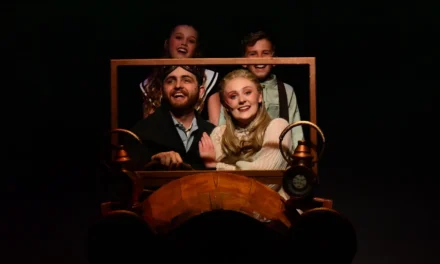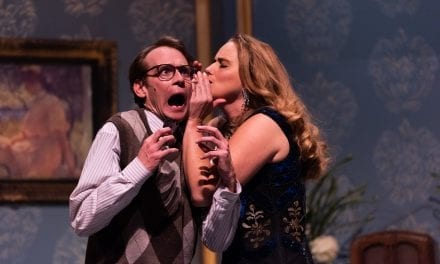PROVO — By definition an adaptation in something new created out of the original. Some things will be lost, others gained. Such is the case with Melissa Leilani Larson’s stage adaption of Jane Austen’s Persuasion, directed by Barta Lee Heiner, now playing at Brigham Young University’s Pardoe Theatre. Austen’s novel has been condensed into a two-and-a-half hour production that both communicates much of the humor of the original, but loses much of the romance.
Like all of Austen’s best-known works, Persuasion is set amongst England’s upper classes and revolves around a heroine that is at once very much a part of that society, but also distanced from it by her own independent thoughts and actions. The heroine in Persuasion is Anne Elliot (Anna Hargadon). At age nineteen Anne had been in love with a young sailor named Frederick Wentworth (Eliot Wood), but having no money nor ties to nobility, she had been advised by her family and confidant, Lady Russell (Brighton Sloan), to break off their engagement.
Seven years later, Anne is an aging spinster—by standards of the time—who is determined to help her father (Tanner Garrett) out of financial ruin following his reckless spending. Anne, by all accounts the bedrock of her family, is also assisting her frivolous sister, Mary Musgrove (Malanie McKay) during her feigned illnesses. It is while she is staying with her sister that she is reacquainted with Frederick Wentworth, now a wealthy sea captain. The two are frequently thrust in the same social circles, but Wentworth’s attentions now seem to fall on the young Musgrove sisters (Christie Clark as Louisa and Elise Osorio as Henrietta). Over time, however, the young girls fall in love with different men.
Larson is one of Utah’s most talented playwrights, and her adaptation easily captures the wit and humor of Austen’s style. There is wry English sarcasm as well as silly satire of the upper class society of the time. The frivolities, excess, and narcissism of the leisure class is accurately conveyed and condemned. Importantly, Larson’s stage version also comes across as a complete work, not as a truncated story missing important details. What does seem absent from this adaptation is the complexity of the heroine and the development and renewal of the love between Anne and Wentworth. In a novel, the inner thoughts of the characters can be fleshed out in paragraphs and pages, but in theatre, most communication occurs through dialogue. Anne’s lines are many, but few concern her own thoughts and feelings.
Moreover, Larson uses a flashback device to show the early love between the young Anne and Wentworth (played by Kimberly Olson and Bryan Bowerman), but the older Anne and Wentworth are given very little stage time alone together, and there is missed opportunity to communicate the continued romantic and physical attachment between the two that would make their final reunion more fulfilling. To be sure, direction plays a role in this dissatisfying element of the production. It seems as if Heiner chose to keep the couple separate on stage rather than find more moments of interaction.
In addition, a very drastic transformation in the young and old Anne is conveyed. While the young Anne possesses a bit more frivolity of youth, she also possesses considerably more joy. The older Anne is helpful and practical, but also comes across as a bit too serious and even a tad dull. This stark contrast also contributes to the sense of disconnect between the older Anne and Wentworth with the younger versions. The clear love and romance of the younger couple is supposed to carry over to the older couple, but because they are so dissimilar, the device doesn’t succeed as well as it might.
In other respects, however, Heiner’s direction is more than satisfactory. She has given her actors as many opportunities for physical humor as Larson gives verbal, and the pace of the play is fast with a consistent rhythm. Energy abounds in the movement on stage, but this also made one wish for more. The cast was limited to the major players, and more bodies in select scenes would, perhaps, give an even greater sense of the leisure class festivity (the budget, no doubt, influenced this decision).
The set, designed by Eric Fielding, was simple but striking, billowy white material engulfed the stage, and draped major set pieces. It gave a sense not only of luxury but of dreams, as if the story was being told as a happily-ending fairy tale in the imagination. The costumes, designed by Landen Gates, were also eye-pleasing and appropriate to the individual characters.
I believe that the acting was strong by all accounts. The cast made a solid ensemble and easily fell into the rhythm of the dialogue. There was a real sense of enjoyment on stage, something that can only be found in live theatre. The one distraction in the acting occurred in the use of dialect, which, in many of the actors, came across as forced and unnatural. This, however, may work itself out during the run of the show. And, it is a show that you should see. Like Austen’s novel, Persuasion at BYU is a medium of escape. You will laugh often and, perhaps, think a little about love.

From left, Elise Osorio as Henrietta Musgrove, Eliot Wood as Captain Wentworth, Christie Clark as Louisa Musgrove, Anna Hargadon as Anne Elliot





